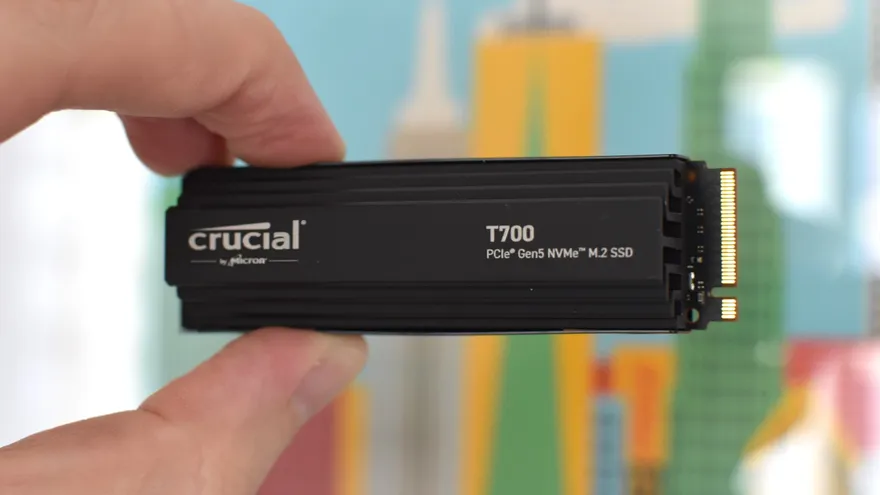
For hardware that’s all about searing speed, advances in SSD tech can be a Beckettian waiting game. Microsoft’s DirectStorage has only so far only found support in the ho-hum Forspoken, and PCIe 5.0 SSDs still aren’t widely available despite the first compatible CPUs and motherboards launching in 2021.
However, the latter are coming soon, and I’ve been testing out an engineering sample of the Crucial T700 to see how PCIe 5.0 – also known as PCIe Gen5 – drives could perform in an honest-to-goodness gaming PC. The short version: with maximum read and write speeds that tower over the current generation’s best SSDs, albeit with less impact on game load times than such explosive pace would suggest.
PCIe 5.0 SSDs, in general, will offer drastically higher performance in simple data transfer tasks as they’ll have twice the bandwidth of PCIe 4.0. And the T700 is quick even by these new standards: the 2TB model, which I’m using, boasts of sequential read speeds up to 12400MB/s and sequential write speeds up to 11800MB/s. Not only are these nearly twice that of the fastest 4.0 drives, like the Samsung 990 Pro and WD Black SN850x, but they top the claimed speeds of what is likely to be a close 5.0 rival: Gigabyte’s Aorus Gen5 1000 SSD. That ‘only’ promises up to 10000MB/s reads and 9500MB/s writes – yeesh, what a slowpoke.
And the price? I can’t say, in the literal sense, as Crucial don’t yet have finalised pricing to share (also hence why this is a feature and not a review). But in terms of drawbacks, PCIe 5.0 models will run hotter than previous generations, so the T700 will need either its own, chunky metal heatsink or the motherboard’s own heat-spreading pads to avoid some nasty throttling.
Compatibility is also a much trickier issue than with PCIe 4.0 and 3.0 drives. Right now, you’d be best off with an AMD Ryzen 7000 CPU and a matching 600 series motherboard, which allows for native 5.0 storage support. Intel’s 12th Gen (Alder Lake) and 13th Gen (Raptor Lake) processors technically support PCIe 5.0 SSDs, but because their motherboard chipsets are lacking in the requisite PCIe 5.0 lanes, you’d basically need to get an adapter and connect the SSD through a PCIe x16 slot rather than M.2. Using an older CPU, or lower-specced motherboard chipset? Then any PCIe 5.0 SSD you install will, at best, run at 4.0 speeds. I had the T700 going at full pelt with an Intel Core i9-12900K, but only after squeezing it into the adapter card that came with my Asus ROG Maximus Z690 Hero mobo. AMD unquestionably holds the advantage here, as you can just pop the drive into an M.2 slot, without an adapter having to share PCIe 5.0 lanes with your PC’s graphics card.
At least the reward for all that handiwork is, in certain conditions, some truly next-generation performance. CrystalDiskMark’s sequential read/write speed tests showed the T700 really could reach 12400MB/s read and 11800MB/s, plus a few megabytes’ change, and although the AS SSD sequential tests produced lower results they were still several gigabytes per second above those of the very fastest PCIe 4.0 drives.
Unfortunately, most actual read/write tasks your SSD performs are not dealing with neat, sequentially stored data. And in the tougher, more representative random read/write benchmarks, the picture of the T700 is more mixed: one of a drive that not only struggles to significantly outpace last-gen SSDs, but is sometimes slightly slower than them.
I’m not convinced this is an issue specific to the T700, or to PCIe 5.0 as a whole; you can see in these graphs that the PCIe 4.0-based Black SN850x had the best sequential speeds in its class while dropping to so-so random read speeds. But it is disappointing that the new-and-improved interface doesn’t guarantee consistently higher performance, only occasionally grabbing a narrow lead.
The T700 wasn’t exceptional for game loading, either. Shadow of the Tomb Raider consistently took dead-on 7s to load in from the main menu to a saved game, a slightly superior time to the Crucial P3 Plus (7.3s) and the Kingston Fury Renegade (9.6s) but just trailing the Samsung 990 Pro (6.6s) and Black SN850x (6.7s).
I’d be interested to run some additional loading time tests on a more retail-ready version of the T700, but the impression I’m getting from this early engineering sample is that it probably won’t be a vital upgrade for anyone on PCIe 4.0 storage. To be fair, I also found more evidence of some excellent file transfer capabilities: its overall score in the main AS SSD benchmark, which combines scores for reads and write across several tests, was 14590. That’s a big step up from the 990 Pro and Black SN850x, which scored 10566 and 10397 respectively. The T700 also set an RPS testing record in the AS SSD copy benchmark, shifting game files at 3646.7MB/s with a final time of 0.38s. The 990 Pro reached 1428MB/s and took 0.97s to complete the same test, while the Black SN850x scored 1610MB/s and took 0.86s.
It’s a shame that the T700 can’t translate this synthetic benchmark power into better games performance, though as someone who forces his gaming PC to wear a entire rack’s worth of other hats – writing work, photo editing, video editing, sound recording, etcetera – I can see the appeal of something that vastly upgrades the speed at which I can shuffle files around or install, uninstall and re-install apps.
The price, mind, will need to be right. Given that early adoption of PCIe 5.0 involves dealing with both high temperatures and compatibility pitfalls, having to pay too much of a premium on top of all that would see that file-wrangling appeal evaporate in short order.
























